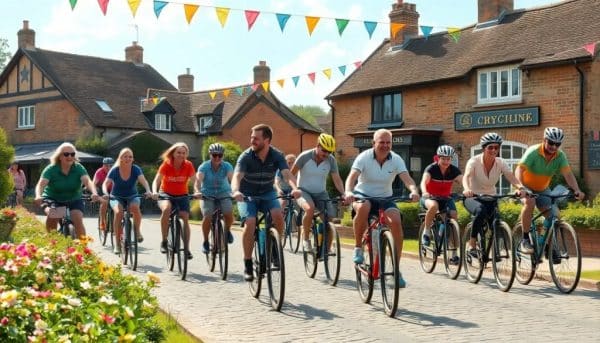Cycling has long been a part of British culture, with deep roots and a rich history that has evolved significantly over the years. From its early days to its current status as both a popular leisure activity and a competitive sport, the cycling culture in the UK has witnessed remarkable changes and innovations.
In this article, we will explore the history of cycling culture in the UK, highlighting key milestones, societal influences, and the ongoing developments that shape the cycling experience today.
Cycling UK history timeline
The timeline of cycling in the UK is punctuated by significant events that not only shaped the sport but also the cultural landscape of the nation. The journey began in 1878 with the formation of the Bicycle Touring Club, now known as Cycling UK. This organization has played a pivotal role in advocating for cyclists' rights and promoting cycling as a means of transport and recreation.
Key milestones in this timeline include:
- 1880s: The introduction of the safety bicycle, which made cycling more accessible.
- 1890s: A surge in cycling popularity, marked by the establishment of numerous cycling clubs.
- 1910s: The emergence of cycling races and events, contributing to a burgeoning sport.
- 1960s: A decline in cycling interest due to the rise of motor vehicles.
- 2000s: A revival of interest in cycling, leading to the establishment of infrastructure improvements.
These events reflect not just the evolution of cycling as a mode of transport, but also its integration into British social life.
What were the early days of cycling in Britain?
In the early days of cycling, the landscape was vastly different from what we see today. Initially, bicycles were considered a novelty, and their adoption was limited. The penny-farthing, introduced in the 1870s, was one of the first popular types of bicycles. However, it was not very practical.
As cycling technology progressed, so did its acceptance. The introduction of the safety bicycle in the 1880s, with two wheels of equal size, made it easier and safer for the general public to ride. This innovation sparked a cycling revolution, with dramatic increases in bicycle sales and club memberships.
The Bicycle Touring Club emerged as a key player during this time, advocating for cyclists’ rights and improving the infrastructure for cycling. Their work laid the foundation for what would become a national cycling culture, emphasizing the importance of safe and enjoyable riding experiences.
How did cycling culture evolve through the decades?
Cycling culture in the UK has undergone significant transformations over the decades. From the late 19th century to the present, various factors have influenced its evolution.
In the 1890s, cycling became a popular pastime for the middle classes, with many cycling clubs forming. The establishment of events like the National Cycling Championships in 1893 helped to formalize the sport.
As we moved into the 20th century, cycling faced challenges during the two World Wars, with many cyclists serving in the military. After the wars, the rise of the automobile saw a decline in cycling popularity. However, the 1960s brought a renewed interest in cycling, partly due to environmental concerns and the oil crisis.
By the 2000s, cycling was experiencing another renaissance, driven by initiatives from organizations such as Cycling UK and the Big Bike Revival program. These initiatives aimed to promote cycling as a healthy, eco-friendly alternative to car travel, leading to significant infrastructure developments across the UK.
What was the cycling frenzy in the 1890s?
The 1890s marked a pivotal decade in the history of cycling in the UK, often referred to as the "Golden Age of Cycling." The introduction of the safety bicycle made cycling more accessible, leading to a surge in popularity.
During this time, cycling clubs flourished, and events became commonplace. The first long-distance cycling events attracted thousands of participants, showcasing the growing interest in competitive cycling. Bicycles were not just modes of transport; they became symbols of freedom and independence for many, especially women.
The media also played a crucial role in promoting cycling, with magazines dedicated to the sport becoming increasingly popular. This frenzy contributed to the establishment of cycling as a significant part of British culture, influencing lifestyle choices and social interactions.
What challenges did cycling face during the inter-war period?
The inter-war period presented unique challenges for cycling in the UK. With the rise of the automobile industry, many cyclists found themselves competing for space on the roads. The increased traffic posed safety concerns, leading to a decline in cycling popularity.
Moreover, the economic hardships of the Great Depression affected disposable incomes, making it difficult for many families to afford bicycles. Despite these challenges, cycling organizations like the Cycling UK continued to advocate for cyclists’ rights, pushing for safer roads and better infrastructure.
During this era, the cycling community also began to focus on the importance of cycling education and awareness, emphasizing safe riding practices to counteract the growing dangers posed by motor vehicles.
What innovations shaped the future of British cycling?
Innovation has consistently played a key role in shaping the future of British cycling. Over the years, several significant advancements have transformed the cycling experience.
One of the most notable innovations was the development of lightweight materials, which made bicycles easier to ride and transport. Additionally, the introduction of gear systems allowed cyclists to tackle varied terrains more effectively.
Another critical innovation has been the improvement of safety features, such as better braking systems and enhanced visibility through lights and reflective gear. These advancements have made cycling safer and more appealing, contributing to the resurgence of cycling in urban areas.
Furthermore, the growth of cycling advocacy organizations has led to significant changes in cycling infrastructure, including the creation of dedicated bike lanes and parking facilities. This enhances the overall cycling experience and encourages more people to choose cycling as a viable mode of transport.
What is the cultural impact of cycling in the UK?
The cultural impact of cycling in the UK is profound. Cycling has influenced various aspects of society, including health, environmental consciousness, and even urban planning. As people become more aware of the health benefits associated with cycling, there has been a shift towards adopting cycling as a primary mode of transport.
Cycling also promotes social interaction and community engagement. Local cycling clubs and events foster a sense of belonging and camaraderie among participants. This community aspect of cycling has led to increased participation and interest in the sport.
Moreover, the role of cycling in promoting sustainability cannot be understated. With growing concerns about climate change, many individuals and organizations are advocating for cycling as an eco-friendly alternative to car travel. This cultural shift has resulted in policy changes and investments in cycling infrastructure across the UK.
What does the future hold for cycling in the UK?
Looking ahead, the future of cycling in the UK appears promising. The growing emphasis on sustainability and health is likely to encourage more people to turn to cycling as a primary mode of transport.
With advancements in technology, electric bicycles are becoming increasingly popular, making cycling accessible to a wider audience. This trend could lead to further growth in cycling infrastructure and community initiatives aimed at promoting cycling.
Additionally, government policies targeting climate change and urban congestion may also support the growth of cycling. Investments in cycling lanes, safety measures, and community programs are expected to continue, shaping a future where cycling is an integral part of British life.
In summary, the history of cycling culture in the UK is characterized by milestones, challenges, and innovations that have all contributed to the current state of cycling. As we look to the future, the ongoing evolution of cycling culture promises to enhance our communities and encourage healthier lifestyles.
Related questions about cycling culture
What is the 75 rule in cycling?
The 75 rule in cycling refers to the principle that cyclists should aim to maintain a pace that allows them to remain within 75% of their maximum heart rate during training. This method helps cyclists build endurance while minimizing fatigue and the risk of injury. By adhering to this guideline, cyclists can improve their performance effectively.
When did bicycles become popular in the UK?
Bicycles began to gain popularity in the UK during the late 19th century, particularly in the 1880s when the safety bicycle was introduced. This model made riding more accessible and comfortable, leading to a surge in cycling clubs and events. The 1890s, known as the Golden Age of Cycling, marked the peak of this popularity, with thousands of people embracing cycling as a recreational activity.
What is the brief history of cycling?
The brief history of cycling can be traced back to the invention of the draisine in 1817, followed by the penny-farthing in the 1870s. The introduction of the safety bicycle in the 1880s heralded a significant increase in popularity, leading to the formation of clubs and events. Over the years, cycling has faced challenges and undergone innovations, ultimately becoming a prominent part of British culture and lifestyle.
What is the 1% rule British Cycling team?
The 1% rule in the British Cycling team emphasizes the idea that small improvements, when consistently applied, can lead to significant overall performance gains. This approach encourages athletes to focus on making minor adjustments in various aspects of their training, nutrition, and recovery. By committing to these incremental changes, cyclists can enhance their performance and achieve their competitive goals.


Leave a Reply